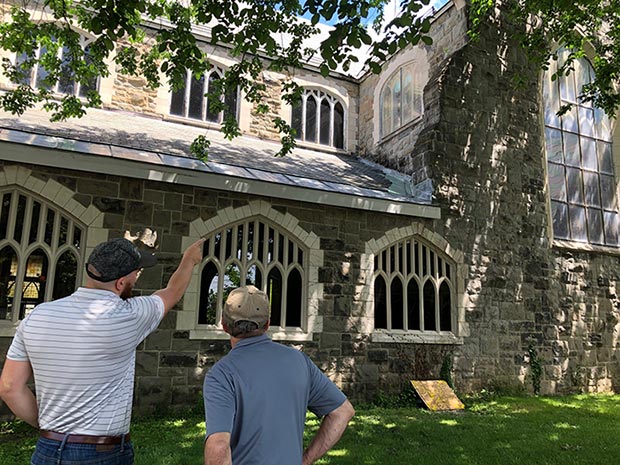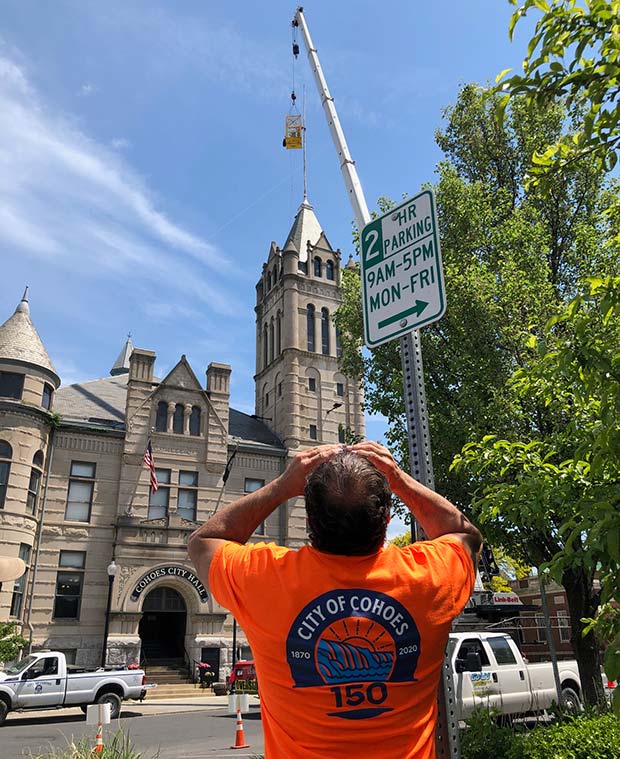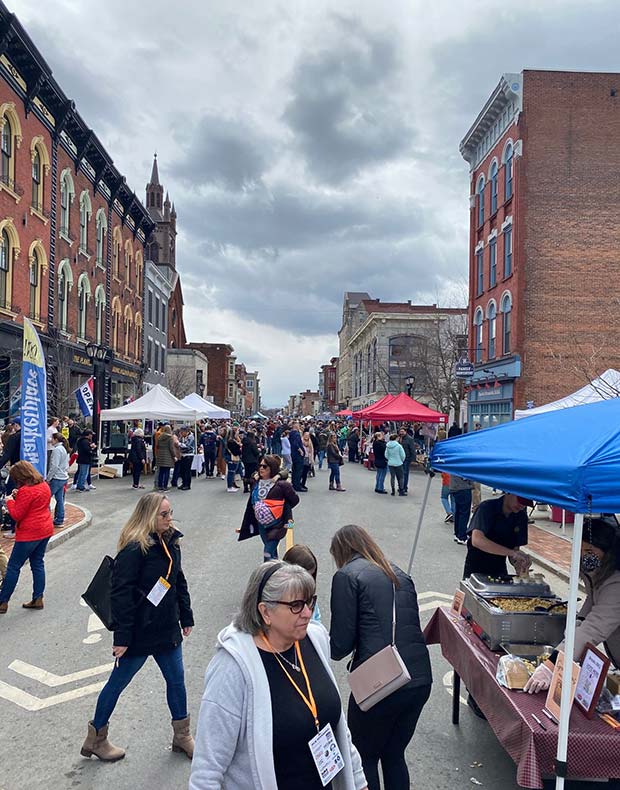NREL Helps Cohoes Community With Floating Solar System and Historic Building Retrofits
Feb. 3, 2023
Through the U.S. Department of Energy's (DOE's) Clean Energy to Communities (C2C) program, NREL helped plan a solar system and building retrofits in Cohoes, New York. Learn how in this blog.
Cohoes is a small working-class community in upstate New York operating with a small staff and limited resources, but its lack of energy-related expertise did not prevent it from pursuing cleaner and more cost-effective energy solutions through the C2C program.

Retrofitting a historic library to be more energy efficient with help from C2C Expert Match is one way the city of Cohoes is following its motto: Honor the past, Explore the present, Inspire the future. Photo from city of Cohoes
"We have a lot of the same struggles that older upstate New York communities or northeastern municipalities have, including aging infrastructure, high electricity and gas bills, and just a lack of technical expertise," said City Planner Joe Seman-Graves. "[C2C] was very valuable because it was almost a one-stop shop to get advice and technical assistance that otherwise would have taken months, potentially longer, to receive."
Before finding C2C, the city knew it wanted to reduce its climate impact, so it searched locally and nationwide for information on solar energy and decarbonizing historic buildings. The city's municipal buildings are old, and many have slate roofs that aren't suitable for solar panels. It also didn't want to use any adjoining farmland for a solar farm, so its options seemed limited.
"One thing we do have is 10 acres of water in our reservoir," explained City Director of Operations Theresa Bourgeois. "So, Joe Seman-Graves had the idea of exploring how we could use that resource to create floating solar."
Bourgeois' research led her to an NREL study in 2018 that talked about the power of floating solar on man-made water reservoirs.
"There are 24,000 potentially suitable water reservoirs in the United States. There are 492 in New York State alone, and we happen to have one of those," said Bourgeois. "That made me understand that not only is floating solar a possibility for our community in Cohoes, but we could become a model for other communities all around the country, particularly low-income communities like ours."
Even though Bourgeois and Seman-Graves had the idea for floating solar and the support from leadership like Cohoes' Mayor Keeler and Congressman Paul Tonko, they needed assistance with planning.
"We didn't have a clear pathway," said Bourgeois. "We wanted to be part of the shift to a clean energy future. But what's the right technology and how do you fund it? Cohoes found that path through the C2C program."
One of the C2C program offerings—Expert Match—was the best fit to provide Cohoes rapid input in a short time frame. The Expert Match team of researchers provided guidance on appropriate design and installation of the floating solar panels.
The result was the design for a 3.2-MW, municipally owned and operated floating solar project—the first of its kind in the nation. Expert Match researchers at NREL analyzed the regulatory structures that would allow the project to share the electricity with the school district and housing authority.
"The idea is if we own and operate the floating solar, then we will be generating all the electricity that we need for our municipal buildings," explained Bourgeois. "There will be up to 40% capacity generated remaining to make sure that that the community gets the broadest benefit for that. We're working with our school district, and we're working with our housing authority to have them share in that. So, what are the legal agreements about that? These are all of the kinds of topics that we needed more technical assistance on."
Cohoes also connected with local university Rensselaer Polytechnic Institute to turn NREL's floating solar data into a data visualization tool—the Floating Solar Explorer. The interactive map offers state-by-state indicators where human-made water reservoirs are potentially suitable for floating solar and layers in economic data by congressional district.
Cohoes expects to install the floating solar array on the water reservoir—the first municipally owned and operated floating solar installation—within the next year.
Historic Building Retrofits

Even though their historic buildings weren't suitable for solar panels, Bourgeois and Seman-Graves knew they wanted to find a way to include them in Cohoes' clean energy future.
"Our city motto is ‘honor the past, explore the present, inspire the future'," said Bourgeois. "So, we wanted to make sure that we make these buildings sustainable in all senses of the word and bring them back to life."
"When it came time to select a path forward for building retrofits, one of our challenges was not knowing what we didn't know," said Seman-Graves. "We had many proposals, but getting an expert, third-party perspective helped us solidify our direction."
So, C2C Expert Match also helped Cohoes review the multiple proposals for reducing these buildings' emissions and understand how to evaluate them. "They provided pros and cons, a deep dive into the technology that's available, and other things that we might not have otherwise considered," said Seman-Graves.
"They provided incredible guidance," added Bourgeois. "Not necessarily telling us what to do, but giving us guidance about how to make these judgments: What are the things that we should be looking for? How should we assess these various proposals? Sometimes we didn't know the right questions to ask."
With insights from the Expert Match team, Cohoes learned about passive design and passive architecture, and was introduced to an architect with relevant expertise. "It has opened up a whole new area of opportunity for us as we think about the most cost-efficient, energy-efficient way to pursue building restoration," said Bourgeois.
The Expert Match guidance on decarbonizing historic buildings has now helped Cohoes advance the building retrofit project into the design phase for HVAC, roofing, windows, and masonry.
Moving Clean Energy Plans Forward Quickly and With Confidence
The Cohoes leaders and NREL Expert Match team worked closely together over the 3-month program period. "The technical advice was wonderful—just the breadth and depth of the expertise that made us feel comfortable moving forward," said Seman-Graves.

Cohoes now has data and tools that it can continue to draw from as it moves forward and applies what it has learned to more projects. "We're going to need to do retrofits for other municipal buildings. [Expert Match] gave us the tools to do the assessments we need to make these decisions and introduced us to other people and resources we can turn to, and that's really invaluable," said Bourgeois. "If you do this right, there's tremendous economic savings in these investments in clean energy and energy efficiency."
The benefits of Expert Match extend beyond near-term decision making. "Cohoes' participation will be transformational for our community for decades," said Bourgeois. "We will take that energy savings and reinvest it back into making our other buildings more energy efficient and improving our community. And that cycle will continue. That gives policymakers at the state level and at the federal level a road map."
Bourgeois and Seman-Graves agree that Expert Match is a worthwhile investment of time. "There are resources out there for under-resourced communities, for working-class communities, particularly communities with historic buildings to make this transformation," said Bourgeois.
Seman Graves added, "I recommend Expert Match if you are a city that is interested in both sustainability and the economic benefits of going green. This would be a great spot for you to get advice and consolidate your time frame."
C2C connects local governments, utilities, community-based groups, and others with national laboratory experts and their customized, cutting-edge analysis to achieve clean energy systems that are reflective of local and regional priorities. Read more about the C2C Expert Match program and learn how to apply.
Share

